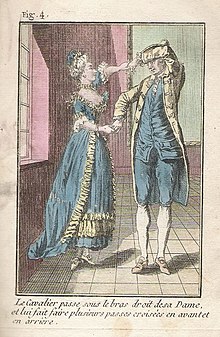Allemande
The allemande (French, from danse allemande "German dance", for "the German"; also Almande, Italian Allemanda, English also Almain and Alman) is since the 16th century and especially the Baroque period a two-part straight-beat scream dance in even time known in France, Spain the Netherlands and England. The first part (Vortanz; formerly also simply called "Dantz") is usually in slow 4/4 time, the second part (Nachtanz or Tanz-Nachtanz; formerly also called "Hupfauf", "Gassenhauer" or "Proportz", Proporz or "Proportio" and later also, for example with Pierre Phalèse, replaced by the Gagliarde) in fast triple time.
It can be assumed that the allemande originated from German folk dances. The pre-dance probably originated from the round dance of the Middle Ages. As the picture shows, arm figures were danced (in the 18th century) in the night dance, which also occur in the Ländler dance.
Later the allemande, like the courante, sarabande and gigue, developed as a dance couple (allemande-tripla) into an integral part of the classical suite of baroque music, where it often forms the first movement of the suite, and appears in this form frequently in Johann Sebastian Bach (French and English Suites), George Frideric Handel and in the Pièces de clavecin of Jean Philippe Rameau.
In its late Baroque variant it likes to move in 16th-note steps, is in straight time and usually has a short upbeat. A distinction is made between the fast allemande (written in alla breve meter) and the slow allemande (written in 4/4 time). In the form of the stylized allemande, the tombeau was composed in the 17th century, of serious character and measured movement. A lively (briskly paced) allemande in the 17th century was also called a ballet.
From the night dance in triple time, the German dance, also called Deutscher, developed around the middle of the 18th century in southern Germany and Austria, as a fast revolving dance one of the forerunners of the Viennese waltz. (The Austrian composer Joseph Lanner first called his dances Deutsche Tänze or Ländler, later Walzer).
The instrumental allemande, as it was written for the guitar by Anthony Holborne in the 16th century in England (as Almain), in the 17th century by Daniel Bacheler, Robert Johnson and in the 17th century as Alemanda also in Spain, developed differently from the danced allemande. Thus Johann Mattheson already wrote An allemande for dancing and one for playing are distinguished like heaven and earth... (Johann Mattheson in: Das beschützte Orchester, Hamburg 1717, p. 138). Such allemandes are more ornamented and richer in harmony, have an extended number of measures (instead of 4 + 4 in instrumental movements 8 + 8 or 8 + 10 or 8 + 8 + 8), a change of one voice to another voice level, stronger syncopation and even rests within the work.

Allemande
Search within the encyclopedia